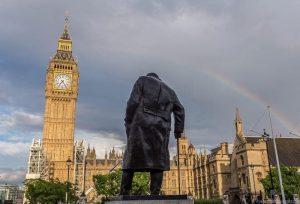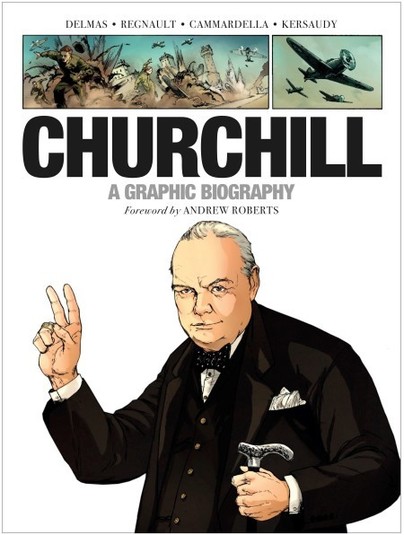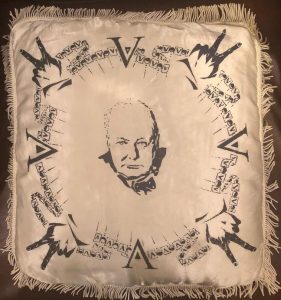
Bulletin #142 – Apr 2020
Portraits de Churchill

March 30, 2020
Review by ANTOINE CAPET
Vincent Delmas and Christophe Regnault (text), Alessio Cammardella and Alessia Nocera (drawings), François Kersaudy (historical commentary), Andrew Roberts (foreword), Churchill: A Graphic Biography, Dead Reckoning, 2020, 112 pages, $19.95. ISBN 978–1784385125.
Readers of Finest Hour may recall The Happy Warrior, the splendid 1958 comic-book depiction of the life of Sir Winston Churchill. In his introduction to the 2008 Levenger Press edition of the book, Richard Langworth wrote: “It’s unlikely that today anyone would publish a comic commemorating, in purely hagiographic terms, any real-life leader, even Churchill.” Ten years later, however, a French publisher did just that—and did it well. The French edition has now been translated into English and includes a foreword by Andrew Roberts.
While the new English edition comes only as a single-volume paperback, the original French edition was published in two hardcover volumes, the first covering up to 3 September 1939 and the second covering the rest of Churchill’s life. They are part of a series, Ils ont fait l’Histoire (They Made History), which also includes Alexander the Great, Julius Caesar, Abraham Lincoln, Georges Clemenceau (so far Churchill would have approved of the company), as well as Robespierre and Lenin (more doubtful).
In a publication of this nature, three points need special attention: the quality of the drawings (first and foremost the faithfulness of the portraits), the accuracy of the dialogue, and the adherence to historical facts.

2024 International Churchill Conference
On the first point it must be said that the faithfulness of the portraits in this new book does not match the extraordinary verisimilitude found in Frank Bellamy’s illustrations for The Happy Warrior. Not that these new drawings are all bad—they can be good on occasion and many are acceptable—but, unfortunately for illustrators Alessio Cammardella and Alessia Nocera, many Churchillians will be familiar with Bellamy’s work. Among the portraits, Asquith, de Gaulle, Eisenhower, and Roosevelt are hardly recognisable; Clementine not at all, which is a pity since we often see her. Balfour, Lloyd George, and Chamberlain vary in their quality. Alan Brooke, who makes repeated appearances, is sometimes very good. Montgomery, however, is always execrable. Certainly Stalin and George VI could have been better.
As for the depictions of Churchill himself, even though he is always recognisable—especially as he gets older—he is often far from perfect. The props are frequently accurate, like his signet ring, but for some reason he is given a conventional bowler hat à la Halifax (another character who is poorly portrayed), not his favourite Bowker or Homburg hats. He is shown naked in his bath and in his dressing-gown (though not the Dragon one), but never shown in his siren suit.
The settings at least are very realistically drawn: Blenheim, Chartwell, the Chamber of the House of Commons, the Houses of Parliament, Buckingham Palace, Northumberland Avenue just after 11 o’clock on 11 November 1918, the Arc de Triomphe and the Champs-Élysées on 11 November 1944, Livadia Palace at Yalta. Clearly the illustrators are much better at architectural artwork than portraiture.
Illustrations aside, the dialogue is excellent: the protagonists—and Churchill himself of course—generally say what they really said according to historical records. Inevitably, a few conventional apocrypha are repeated, like “Winston is back,” but on the whole the words used are remarkably exact. Naturally the great 1940 speeches feature: “Blood, toil, tears and sweat” and “Their finest hour.” It seems, however, that on occasion the double translation—first from English into French and then from French back into English—leads to a slight distortion, such as with the famous 1932 warning against “these bands of sturdy Teutonic youths…with the light of desire in their eyes to suffer for their Fatherland,” which becomes “these groups of young vigorous Germans…motivated to sacrifice themselves for the Fatherland.” It is obvious that Ivanka Hahnenberger, the French-to-English translator, did not look up the original phrasing.
As for historical accuracy, this new work almost gets full marks. Controversial episodes like the Dardanelles are treated with nuance, giving Churchill credit for the fact that he had had the backing of many of those who only blamed him for the fiasco later. The only ambiguity that I could detect was when Dr. Roose announces to Jennie that Lord Randolph is dying from syphilis. But a few frames down, he tells Churchill that the cause of his father’s death is a mystery. The uninformed reader will be confused, unfortunately.
A nice feature of the book is that the comic strip proper is complemented by commentary from historian François Kersaudy, the foremost Churchill scholar in France, who provides welcome additional information—eight pages in each French volume, nine pages altogether in the English version—with material useful to the young public for which the book is presumably intended: maps (only in the French version), photographs (different in both editions), and a basic chronology (only in the French volumes).
In his foreword to the English edition of “this superb book,” Andrew Roberts writes: “I hope [it] will bring the Churchill story to an entirely new generation of enthusiasts, who might then go on to join the International Churchill Society to learn more about the Greatest Englishman.” No mean compliment from the author of the acclaimed Churchill: Walking With Destiny.
Antoine Capet is Emeritus Professor of British Studies at the University of Rouen and author of Churchill: Le Dictionaire (2018).
Subscribe
WANT MORE?
Get the Churchill Bulletin delivered to your inbox once a month.




